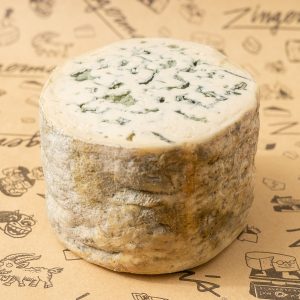Excerpt from Ari’s Top 5 enews
This beautiful traditional blue cheese makes for some really fine eating

While I’ve always liked it, I can’t say that the French cheese Fourme d’Ambert has even been at the top of my list of favorites. That all changed last week—the Fourme d’Ambert we have now in Ann Arbor is one the best things I’ve tasted in ages!
While my enthusiasm for it is new, Fourme d’Ambert has been around for a good five centuries. Its history goes back to the Middle Ages when it was made by farmers in what is now the Auvergne region of France from the milk of the local breed of Occitane Ferrandaises cattle. Legend has it that Celtic Druids used it for celebrations at the time. With adjustments for technology, the basic process remains roughly the same today. In 2002, Fourme d’Ambert got its own appellation d’origine contrôlée; it can only be used for the cheeses produced in Auvergne, requires that the animals are milked only when they are grazing in the pasture and that any added feed must come from forage of the region. Fourme d’Ambert is always made into medium-sized—about five pounds—cylinders, not unlike a much smaller English Stilton. Sean Hartwig at the Deli adds how much he likes the look: “I love how the cylinders tend to slump thanks to such moisture and richness.”
The marvelous cheese we have on hand is selected by the Mons family in Lyon, who’ve been doing great work choosing and maturing cheeses for well over half a century! Kudos to them—and the cheesemakers and the cows—for the Fourme’s fine flavor. Be sure to let the cheese get to room temperature where its natural full flavor can most effectively come to the fore. Its soft texture and complex flavor are terrific—meaty, mushroomy, almost a hint of bacon, a wisp of smoke, caramelized sugar, a tiny bit of natural sweetness from the milk, and a lovely salt level. As I said up top, it’s terrific. Put some on salad, have it for lunch with a baguette, or let it melt atop a steak or a burger. And it’s truly terrific with honey, especially the lovely chestnut honey we have at the Deli. An easy and exceptionally excellent dessert!
Back when Fourme d’Ambert was first made, the region would likely have been referred to by locals, not as France, but as Occitania. It’s interesting to me at times to remember that the way we’ve come to accept political boundaries of modern nation-states is not the only way that these things could have gone. Where central France is today, we might well have had a country called Occitania, which would include the southern half of modern France, some of the valleys of the Italian Alps, the Aran Valley in the Pyrenees in Catalonia (where Occitane remains the official language), and Monaco. Occitane, like Breton, Catalan, Irish, and other indigenous old languages offer old ways that can be revived. The name “fourme” comes from the old Occitan word fourmaige (or in French, fromage).
There are a fair few bands that play versions of the traditional Occitane music. La Mal Coiffée, which I think translates as “bad haircut” in Occitane, began singing and playing old Occitane folk songs back in 2002. In the spirit of what I wrote above about finding one’s voice in a way that is true to self, and makes a difference in the world, the band shares,
We see ourselves as a piece of the world, a fragment of culture, a vector of language. As human cultures are leveled by media power and societies unravel into digital solitudes, we strive to fabricate bits of identity. … It is to be rebellious. Thus, we hope to meet all those who are thirsty for particular stories, whether they are from here or there. Inspired by all these peasants who understood that it was necessary to stay away from industry and mass distribution if they wanted to feed the world properly, we try to stay away from the dominant cultural models. Our language ? … It is both the language of poetic reconquest of an indigenous thought, enjoyment, and musical instrument.
When I savor small pieces of the Fourme d’Ambert, I like to imagine its Occitane roots, a bit of rebellious and poetic reconquest that takes us back to what great indigenous cheese was like long before the era of industrialization! Enjoy! Or as they say in Occitan, Bon apetís!



